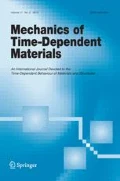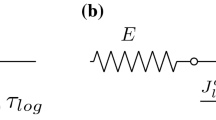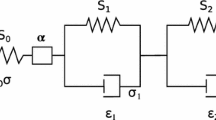Abstract
This paper focuses on the modeling of linearly viscoelastic, mechano-sorptive behavior and its effects during moisture content changes in timber. A generalized Kelvin–Voigt model integrating specific hygro-lock springs is developed and associated, in series, with a shrinkage–swelling element. The coupling between moisture content state and mechanical state implies an evolution in rheological parameters. This alternative approach leads to incorporating strain blockings during the drying period as well as memory effects during wetting phases after unloading. An incremental formulation is also established using a finite-element software, and, moreover, an experimental validation from tensile creep-recovery tests is presented.
















Similar content being viewed by others
References
Armstrong, L.D., Kingston, R.S.T.: Effect of moisture changes on creep in wood. Nature 185, 862–863 (1960)
Bazant, Z.P.: Thermodynamics of solidifying or melting viscoelastic material. J. Eng. Mech. 107, 933–955 (1979)
Bazant, Z.P.: Constitutive equation of wood at variable humidity and temperature. Wood Sci. Technol. 19, 159–177 (1985)
Bazant, Z.P., Carol, I.: Viscoelasticity with aging caused by solidifying of nonaging constituent. J. Eng. Mech. 119, 2252–2269 (1993)
Bazant, Z.P., Huet, C.: Thermodynamic functions for aging viscoelasticity: Integral form without internal variables. Int. J. Solids Struct. 36, 3393–4016 (1999)
Cariou, J.L.: Caractérisation d’un matériau viscoélastique anisotrope: le bois. Ph.D. Thesis, University of Bordeaux I, France (1987)
Chassagne, P., Bou-Saïd, E., Julien, J.F., Galimard, P.: Three dimensional creep model for wood under variable humidity—Numerical analyses at different material scales. Mech. Time-Depend. Mater. 9, 203–223 (2006)
Dinwoodie, J.M., Paxton, B.H., Higgins, J., Robson, D.J.: Creep in chipboard. Wood Sci. Technol. 26(1), 39–51 (1991)
Dubois, F., Randriambololona, H., Petit, C.: Creep in wood under variable conditions: Numerical modelling and experimental validation. Mech. Time-Depend. Mater. 9, 173–202 (2005)
Feninat, F.E.L., Laroche, G., Fiset, M., Mantovani, D.: Shape memory materials for biomedical applications. Adv. Eng. Mater. 4, 91–104 (2002)
Fortino, S., Mirianon, F., Toratti, T.: A 3D moisture-stress FEM analysis for time dependent problems in timber structures. Mech. Time-Depend. Mater. 13(4), 333–356 (2009)
Frandsen, H.L.: Selected constitutive models for simulating the hygromechanical response of wood. Department of Civil Engineering, Aalborg University (2007). ISSN 1901-7294 DCE
Frandsen, H.L., Damkilde, L., Svensson, S.: A revised multi-Fickian moisture transport model to describe non-Fickian effects in wood. Holzforschung 61(5), 563–572 (2007)
Gandhi, M.V., Thompson, B.S.: Smart Materials and Structures. Chapman & Hall, London (1992)
Genevaux, J.M., Guitard, D.: Anisotropie du comportement différé: essai de fluage à température croissante d’un bois de peuplier, pp. 155–166. Groupement Scientifique Rhéologie du Bois, Bordeaux (1988)
Ghazlan, G., Caperaa, S., Petit, C.: An incremental formulation for the linear analysis of thin viscoelastic structures using generalized variables. Int. J. Numer. Methods Eng. 38, 3315–3333 (1988)
Gril, J.: Une modélisation du comportement hygro-rhéologique du bois à partir de sa microstructure. Ph.D. thesis, Ecole Polytechnique, University of Paris VI, Paris (1988)
Gril, J.: Principles of mechano-sorption. In: International COST 508 Wood Mechanics Conference (1996)
Grossman, P.U.A.: Requirements of models that exhibit mechanosorptive behavior. Wood Sci. Technol. 10, 163–168 (1976)
Hanhijärvi, A.: Advances in the knowledge of the influence of moisture changes on the long-term mechanical performance of timber structures. Mater. Struct. 33, 43–49 (2000)
Hanhijärvi, A., Mackenzie-Helnwein, P.: Computational analysis of quality reduction during drying of lumber due to irrecoverable deformation. I: Orthotropic viscoelastic-mechanosorptive-plastic material model for the transverse plane of wood. J. Eng. Mech. 129(9), 996–1005 (2003)
Haslach, H.W.: Time-dependent mechanisms in fracture of paper. Mech. Time-Depend. Mater. 13, 11–15 (2009)
Hunt, D.: Creep trajectories for beech during moisture changes under load. J. Mater. Sci. 19, 1456–1467 (1984)
Hunt, D.: Longitudinal moisture-shrinkage coefficients of softwood at the mechanosorptive creep limit. Wood Sci. Technol. 22, 199–210 (1988)
Hunt, D.: A unified approach to creep of wood. Proc. R. Soc. Lond. A 455, 4077–4095 (1999)
Husson, J.M., Dubois, F., Sauvat, N.: Modélisation du comportement mécanosorptif des éléments en bois. Eur. J. Environ. Civ. Eng. 12(9–10), 1181–1193 (2008)
Husson, J.M., Dubois, F., Sauvat, N.: Elastic response in wood under moisture content variations: Analytic development. Mech. Time-Depend. Mater. 14, 203–217 (2010)
Husson, J.M., Dubois, F., Sauvat, N.: A finite element model for shape memory behavior. Mech. Time-Depend. Mater. 15, 213–237 (2011)
Ladevèze, P., Sanchez, Ph., Simmonds, J.G.: Beamlike (Saint-Venant) solutions for fully anisotropic elastic tubes of arbitrary closed cross section. Int. J. Solids Struct. 41, 1925–1944 (2004)
Liu, Y., Gal, K., Dunn, M.L., Greenberg, A.R., Diani, J.: Thermomechanics of shape memory polymers: Uniaxial experiments and constitutive modeling. Int. J. Plast. 22, 279–313 (2006)
Mackenzie-Helnwein, P., Hanhijärvi, A.: Computational analysis of quality reduction during drying of lumber due to irrecoverable deformation. II: Algorithmic aspects and practical application. J. Eng. Mech. 129(9), 1006–1016 (2003)
Martensson, A.: Mechanical behavior of wood exposed to humidity variation. Ph.D. thesis, Lund University, Sweden (1992)
Mukuday, S., Yata, S.: Modeling and simulation of viscoelastic behavior (tensile strain) of wood under moisture change. Wood Sci. Technol. 20, 335–348 (1986)
Navi, P., Heger, F.: Thermohydromécanique du Bois. Presses Polytechniques et Universitaires Romandes (2005)
Otsuka, K., Wayman, C.M.: Shape Memory Materials. Cambridge University Press, New York (1998)
Pittet, V.: Etude expérimentale des couplages mécanosorptifs dans le bois soumis à des variations hygrométriques contrôlées sous chargement de longue durée. Ph.D. thesis, Federal Polytechnic School of Lausanne (1996)
Randriambololona, H.: Modélisation du comportement différé du bois en environnement variable. Ph.D. thesis, University of Limoges, France (2003)
Ranta-Maunus, A.: The viscoelasticity of wood at varying moisture content. Wood Sci. Technol. 9, 189–205 (1975)
Salin, J.G.: Numerical prediction of checking during timber drying and a new mechanosorptive creep model. Holz Roh- Werkst. 50, 195–200 (1992)
Schapery, R.A.: Nonlinear viscoelastic and viscoplastic constitutive equations based on thermodynamics. Mech. Time-Depend. Mater. 0, 1–32 (1997)
Taylor, R.L., Pister, K.S., Goudreau, G.L.: Thermomechanical analysis of viscoelastic solids. Int. J. Numer. Methods Eng. 2, 45–59 (1970)
Toratti, T.: Creep of timber beams in variable environment. Ph.D. thesis, Helsinki University of Technology (1992)
Zienkiewicz, O.C., Watson, M., King, I.P.: A numerical method of viscoelastic stress analysis. Int. J. Mech. Sci. 10, 807–827 (1968)
Zocher, M.A., Groves, S.E., Allen, D.H.: A three-dimensional finite element formulation for thermoviscoelastic orthotropic media. Int. J. Numer. Methods Eng. 40(12), 2267–2288 (1997)
Author information
Authors and Affiliations
Corresponding author
Rights and permissions
About this article
Cite this article
Dubois, F., Husson, JM., Sauvat, N. et al. Modeling of the viscoelastic mechano-sorptive behavior in wood. Mech Time-Depend Mater 16, 439–460 (2012). https://doi.org/10.1007/s11043-012-9171-3
Received:
Accepted:
Published:
Issue Date:
DOI: https://doi.org/10.1007/s11043-012-9171-3




